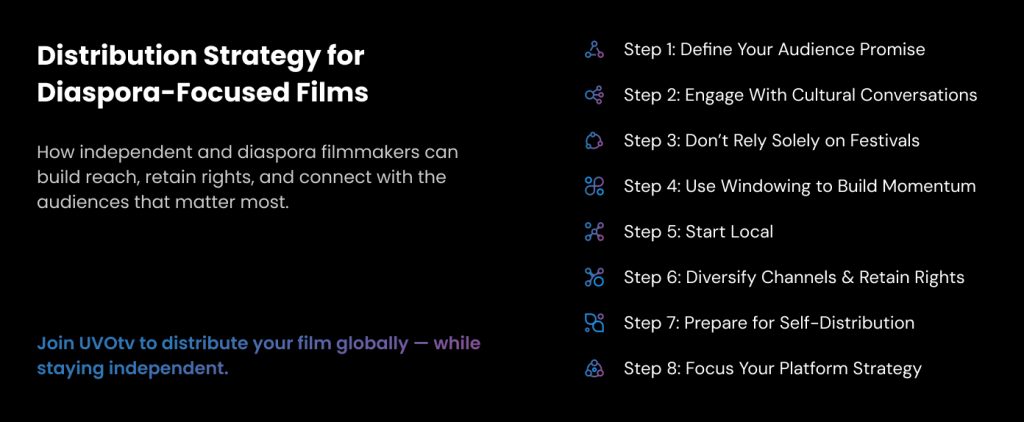Independent and diaspora-focused filmmakers face a double challenge: making a great film and ensuring it reaches the right audience. Whether your goal is to educate, inspire, or entertain, success depends on building clarity, consistency, and long-term trust with your viewers.
At the same time, a recent study by Parrot Analytics, the global audience intelligence firm known for measuring content demand and viewership trends, highlights a major gap in reach for independent cinema. According to the U.S. Independent Film Audience & Landscape report, 76.3 million Americans express interest in independent films, yet only 36.7 million actively watch them, leaving an untapped audience of roughly 40 million potential viewers.
The following lessons, drawn from industry playbooks and real-world case studies, outline how independent creators of diaspora-focused films — in the U.S. and beyond — can close that gap, stay independent, and connect with the audiences that matter most.
Creating a Distribution Strategy for Diaspora-Focused Films
Earlier, we covered film marketing strategy for targeting diaspora viewers, and below are hands-on steps to lock you in with your desired audience.
Pick Your Audience Promise and Stay True to It
Even after your film is released, your job isn’t done. You still need to think about what comes next — and how to keep your audience engaged. In his book Rise of the Filmtrepreneur, Alex Ferrari, creator of Indie Film Hustle podcast, argues that every filmmaker should pick a lane: educate, inspire, or entertain. Trying to do all three at once usually dilutes your message. Audiences tend to tune out when content feels scattered.
Such brand clarity is what builds long-term trust and consistency, so viewers know what to expect. Audiences remember creators who know who they are.
Piggyback on Popular Conversations
Piggybacking means joining conversations that already matter to your niche. For diaspora filmmakers and diaspora film promotion, that could mean creating commentary, analysis, or companion content around cultural moments or shared experiences—without naming copyrighted works. That can help you attract viewers who are already engaged with similar themes.
Don’t Rely Solely on Festivals
Festivals are great for credibility and community, but they’re not distribution strategies. Many indie films for diaspora audiences get festival buzz but never achieve distribution deals, and this is why the “lottery ticket” mentality—thinking that being selected at a major festival will automatically open the golden gate of distribution—is dangerous.
Instead, treat film festival strategy as one window in your plan. Use them to gather feedback, connect with peers, and build early momentum.
Use Windowing to Maximize Exposure
Windowing means staggering your film’s release across different platforms and audiences, each stage feeding into the next. This not only maximizes visibility but also prevents your film from peaking and disappearing too soon.
The key is patience and planning. Each stage should build anticipation for the next rather than compete with it. A strong release sequence might look like this: community screenings → festivals → transactional or ticketed events → streaming → educational or non-theatrical licensing. Each step serves a purpose. Local or community screenings create buzz and word of mouth. Festivals add credibility and press coverage. Paid or limited screenings test demand. And streaming keeps your film accessible once that momentum has built.
Studios have long understood this principle. They spend heavily on marketing and keep the conversation going as long as possible. Independent filmmakers can use the same logic, just scaled to their resources.
For diaspora and ethnic niche films, windowing in film distribution can also help avoid audience fatigue. Your core community might attend early screenings or share the trailer, but the wider diaspora audience often discovers your work later through streaming platforms or social media.
Start Local: The Power of Regional Cinema
Sometimes, the smartest way to reach a global audience is to begin with the one right outside your door. The regional cinema model proves that you don’t need Hollywood connections to make your film matter. That could be your hometown, your diaspora hub, or a region that reflects your story’s culture and values.
It leans into the four-walling distribution, which means renting a theater or venue to screen your film, essentially becoming your own exhibitor. You pay a set rental fee (daily, nightly, or weekly) and, in return, keep all or most of the ticket sales. By engaging the people who live there—community centers, cultural groups, local press — you can turn that region into your first and most loyal audience.
It’s a powerful way to take control of your release. You choose the date, location, and marketing approach. For diaspora-focused films, it can also be a strong community-building tool. The regional model also allows filmmakers to validate their stories before scaling. You can test audience response in your local area, gather reviews and data, then use that momentum to expand online.
But the risks are also there, as always. The upfront rental costs are yours whether or not seats fill. You’re also responsible for promotion, ticketing, and logistics—meaning the workload and financial pressure fall squarely on your shoulders. And because each event is location-bound, reach is limited unless you can tour multiple cities.
Diversify Channels, Retain Rights
Many filmmakers still hand over all rights to a single distributor, which can limit flexibility and slow down future opportunities. A better strategy is to separate your rights by format or region: theatrical, digital, educational, international, so your film can reach different audiences without being tied down.
Owning your rights gives you options. You can sell directly, license selectively, or repackage your film for new markets. It also means you stay in charge of how and where your work lives, instead of waiting on one partner to act.
UVOtv supports that independence. We help creators reach global audiences through ad-supported streaming while letting them keep ownership and flexibility across other windows. It’s a practical balance: real exposure, real revenue, and no locked-in contracts.

Self-Distribution Works Best When You’re Prepared
Simply uploading your film to a platform doesn’t guarantee discovery. Many filmmakers rush this stage — they finish a film, run out of energy and marketing funds, and then hope for a miracle. Without a plan, even a great film can disappear in the noise.
Filmmakers who succeed in this space treat self-distribution like running a small business. That means developing your film with a niche audience in mind, building relationships with that audience before release, and testing whether your story resonates through market research, teaser content, or early screenings. The most effective self-distributors have three things in common:
- They already have access to a defined community, whether through social media, cultural organizations, or shared interests.
- They set aside part of their budget (ideally 20–25%) for marketing, understanding that awareness is as vital as production quality.
- They build partnerships with niche media, local institutions, or online platforms that align with their audience.
Focus Your Platform Strategy Rather Than Spreading Too Thin
Uploading your film across every streaming platform might sound strategic, but it often spreads your marketing efforts too thin and dilutes impact. A focused approach lets your film build momentum instead of disappearing into the crowd.
With clear goals, audience insights, and the right platform support, it can be a highly rewarding path. This bottleneck can make it hard for smaller productions or culturally specific stories to find space. But ad-supported video platforms (AVOD) offer another path, one that rewards accessibility. AVOD models make films available for free while monetizing through advertising. Viewers watch without paying a subscription, and creators earn ongoing revenue as their films continue to be discovered.
UVOtv supports ad-supported distribution designed specifically for diaspora and niche films, helping creators reach audiences who prefer free, legal access to culturally relevant content. Unlike traditional deals that demand all-in exclusivity, UVOtv lets creators retain control of their rights across multiple windows while earning from their films over time.
Marketing Diaspora Cinema Made Easier With UVOtv
For diaspora filmmakers, visibility shouldn’t depend on luck or gatekeepers. With UVOtv, your stories stay in your hands — and in front of the audiences who value them most.For many diaspora-focused filmmakers, long-tail visibility and passive income can outperform short-lived transactional or subscription releases. Unlike traditional distribution deals that demand exclusivity or large upfront costs, UVOtv allows filmmakers to retain control, earn from ad-supported streaming, and grow visibility organically. Join UVOtv as a creator today.





